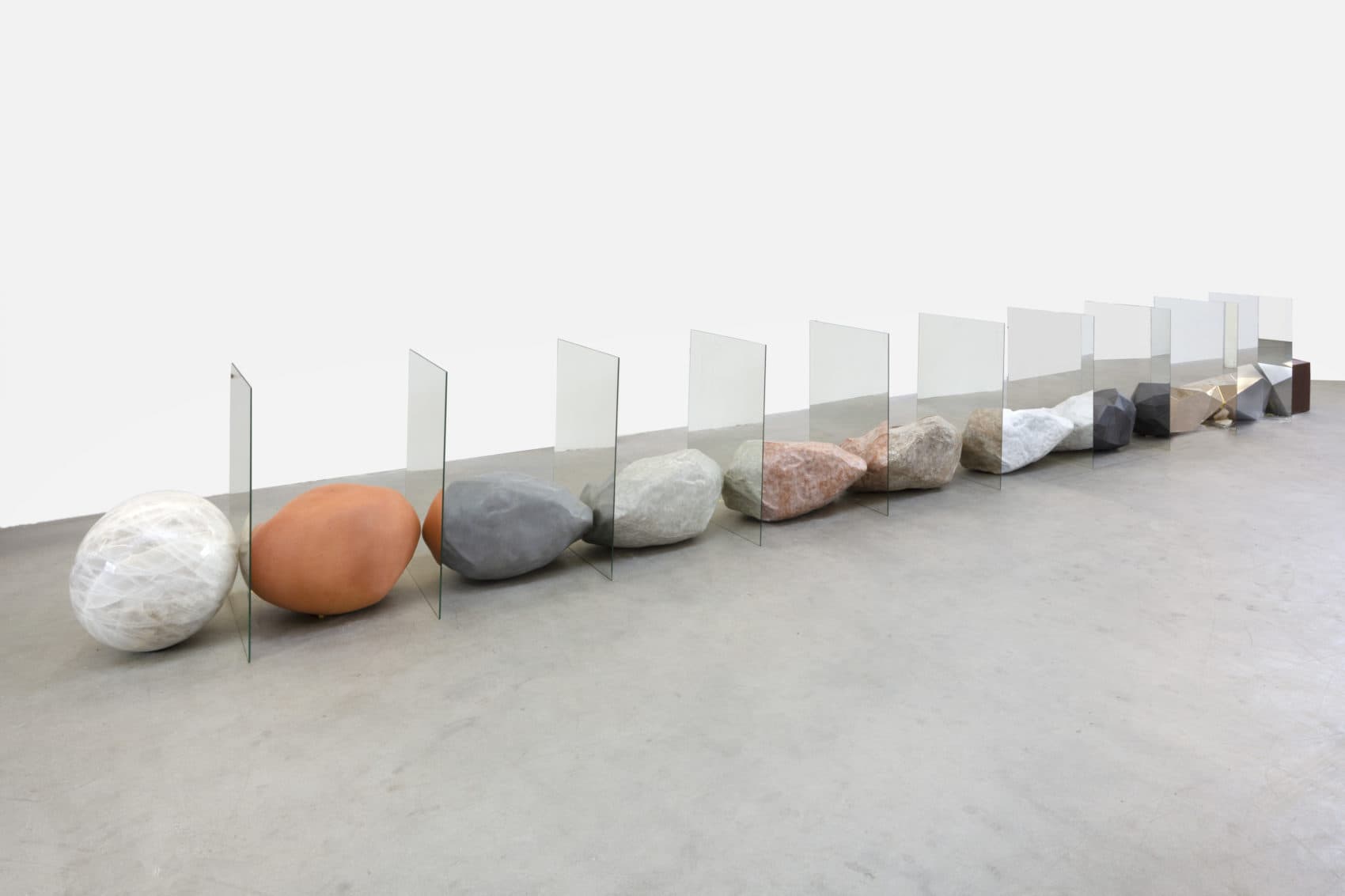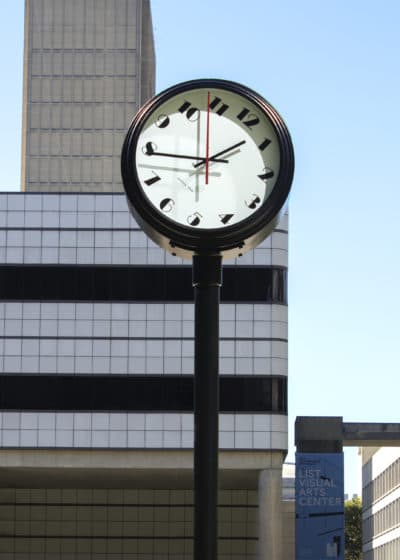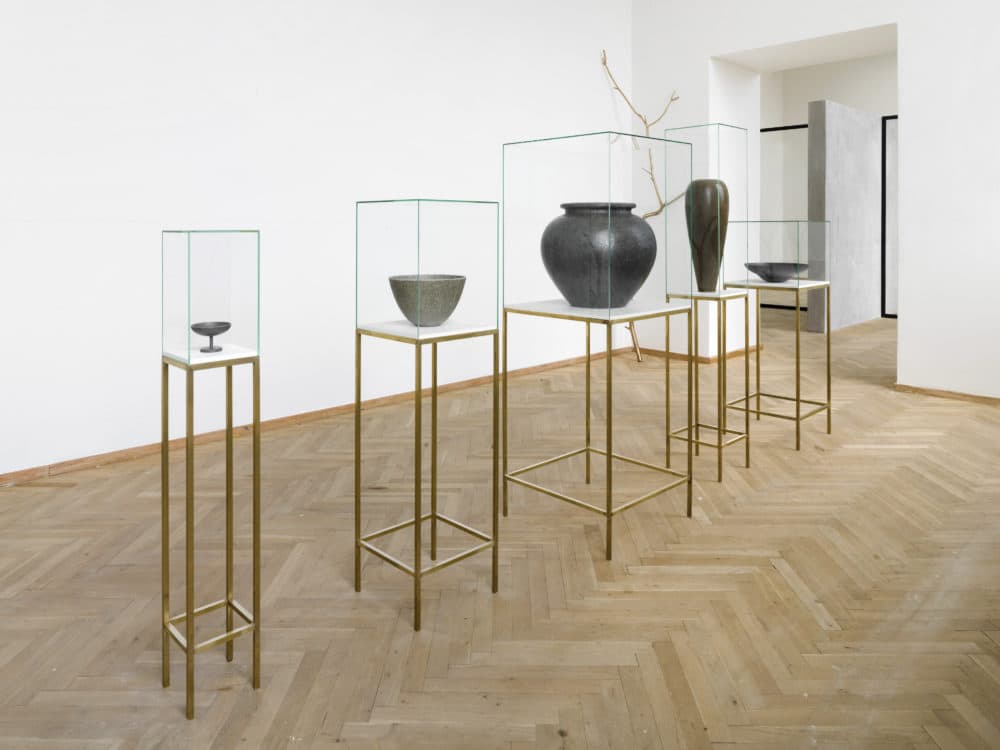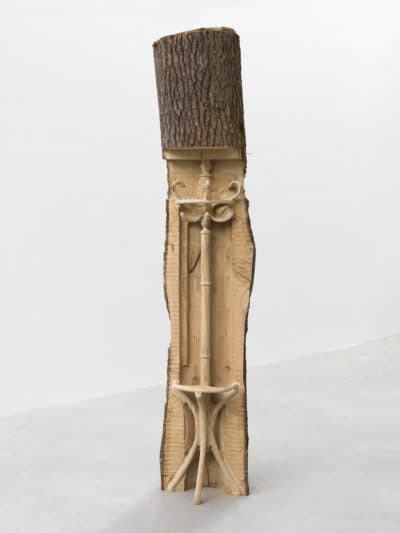Advertisement
At MIT List, Alicja Kwade's 'In Between Glances' Asks Whether We Can Believe Our Eyes

A chair is a bike. A kitchen clock is a vase. A lamp is a bowl. A stone, as seen in a mirror, is no longer a stone, but only a symbol of a stone.
In Alicja Kwade’s world, nothing is what it may seem.
“I am not saying that everything is an illusion” explains Kwade, in an interview conducted by email. “I am just believing that there is no ‘independent,’ meaning objective/neutral knowledge, and it all depends on the background of the story, and your subjective point of view. And this is the main topic in my work.”
With “In Between Glances,” on view at the MIT List Visual Arts Center beginning Oct. 18 through Jan. 5, the Polish-born Berlin-based artist continues to explore our deepest existential questions revolving around the nature of perception, the meaning of time and space, and the “structures” that organize our thinking about the world. What is real and what isn’t?

“I think she is fundamentally interested in the existence of alternate realities or systems and makes these artworks that expose the constructed nature of our reality,” says Henriette Huldisch, director of exhibitions and curator at the List.
In fact, it is our man-made “structures” — systems like the alphabet, numbers, time, units of measurement — that we’ve all mutually agreed to use to describe and characterize our world. But what do such systems leave out?
“Everything is everything is nothing,” Kwade says. “All we experience is basically empty. Each object/subject, including ourselves, is just a happening in space and time and just one possibility of many. I try to figure out what is making an object: language, function, society. But for me, there are no objects existing just by themselves.”
Keen on dismantling our coveted organizational systems, Kwade twists our perceptions even before we step foot in the museum door. Outside the List, in the middle of MIT’s Fleischner Plaza stands “Against the Run” (2019), which confounds one dominant construct ruling our days — time. It is a clock of the sort once commonly seen in parks and plazas, only this one has a face that makes it almost impossible to read, even while it tells the correct time. As the clock hands turn to the right, the face simultaneously moves to the left. Kwade made another version of the clock in 2015. That version, based on a 19th-century design, appeared in New York’s Central Park. This version is more streamlined and was acquired by MIT to remain on school grounds to befuddle students during the run of the show and to ultimately stand in Kendall Square, where it will befuddle tech workers already late getting to the office.
“This is a funny, rather humoristic work and I am very happy that it ended up at the MIT campus,” says Kwade. “It is trying to escape itself, in a nowhere leading action.”
Inside the List, Kwade continues to toy with how we order our world. In one gallery, we find a series of objects that have been pulverized to sand-like granules and reconstituted into decorative vases, urns and bowls retaining the same overall mass of the original object. The ground objects include a kitchen clock, a mirror, an iPhone and a computer, objects that structure and organize our lives, for better or worse. When a computer gets transformed into a graceful urn, it feels a bit like alchemy. (Kwade also subjected her own bike to the same process in a new work entitled “Fahrrad” or “Bicycle.”)
“I like this comparison with magic, but not in a ‘romantic’ way,” says Kwade. “Magic works with distraction and the inattentiveness of the viewer, whereas I try to discover these moments in the comprehension of our world. I try to pay attention to the inattention. But I also use it to transform objects and change views depending on the viewers’ position, which can also be translated to society and so-called ‘truths’ which always depend on the point of view.”

A second body of “object-tree” works consists of three tree trunks that are also a partially carved bar chair, clothes tree and a walking stick. On one side there is the rough bark of the tree, as it would appear in the forest. On the other side is the partially completed machine-carved object. Kwade, who works with 15 to 20 assistants to produce her technically-challenging pieces, used a computer numerical control robot to mill out the objects, leaving the objects (and tree) in an in-between state of suspension bearing no sign of a human hand.
“I want to keep the pure ‘information,’” she says. “I truly believe that we are increasingly moving toward a dematerialized future and are going to sit only on the information of a ‘chair’ rather sooner than later… Actually, we are already doing this — a chair is the result of the information of our normed body measurements, and its social use and the language we name it with, the work and value — but actually, it’s the same as the tree.”
In another work entitled “Trans-For-Men 11 (Fibonacci),” Kwade places a series of large stones in a row, separated one from the other by a mirror. Seeing the stones reflected like this, a viewer can’t help but focus more on the reflection than the stone itself.

“You have different natural and cast materials, including berg crystal, ceramic, sandstone, concrete, limestone, granite and marble, in different forms that undergo a material transformation in both directions,” says Huldisch.
“It is a question of where an object starts and ends and how it is defined,” Kwade says of this piece. “Where does this ‘reality’ begin and end, and if there is any at all?”
In a different gallery, we find a newly-commissioned work, “Light Touch of Totality,” consisting of five large-scale, stainless-steel spherical rings measuring about 16 feet across, incorporating 1400 strands of beads made from wood and lapis lazuli, referencing systems like numbers and the abacus to better know our world, and planetary space orbits, which might suggest the unknowable.
“The sculpture is about the void and about endless options and information,” says Kwade. “The rings circumscribe something in between, an orbital movement, but the middle of the rings remains empty. It is about trying to achieve knowledge of the ‘whole-thing’ — a knowledge we can never get, because we are stuck on our orbit of human possibilities. So, we are spinning and turning around ourselves and we can just get a ‘Light Touch of Totality’ but we will never be able to get to the core of it.”
Kwade’s work, touching on scientific and philosophical ideas, certainly feels at home at MIT. Scientists may be intrigued by her exploration of abstruse scientific and mathematical concepts using everyday material objects, and everyone else may simply delight in both the surprise and the formal elegance of her work.
And as for Kwade, she is unperturbed by having to prove herself to any audience.
“That's the good thing about being an artist,” she says. “It can also be absolute nonsense, but it is absolutely right as long as one moves something, allows an unusual thought, provokes or satisfies.”
“Alicja Kwade: In Between Glances” is at the MIT List Visual Art Center from Oct. 18 through Jan. 5, 2020.
